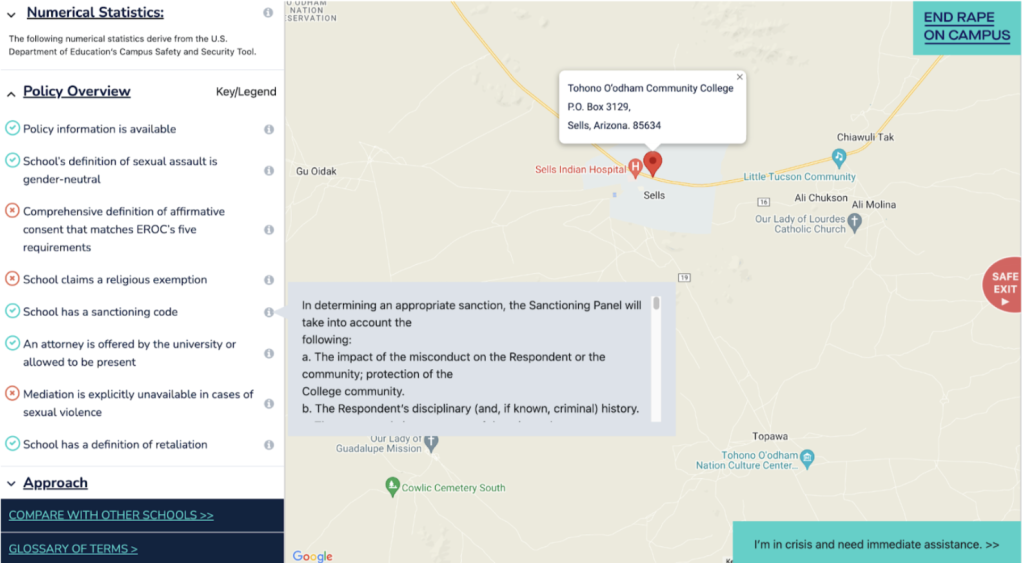After being sexually assaulted at age 18 at UC Berkeley, Sophie Karasek knew she never wanted her offender to violate anyone else again. A year later, she co-founded “End Rape on Campus,” with student survivors Annie E. Clark and Andrea Pino, in the hopes to bring national attention to sexual violence and justice to its victims.
Ten years later, EROC has become the first-of-its-kind one-stop tool for college students to access sexual assault statistics, resources, and direct support for victims.
The recently launched Campus Accountability Map and Tool is the first interactive tool that allows students to easily access and compare sexual assault statistics across 750 colleges and universities in the United States, according to EROC executive director Kenyora Parham.

This tool allows incoming college students to compare and contrast sexual assault cases, campuses investigation policies, and survivor support resources for different schools across the nation.
“There was no centralized way showing how a school handles sexual assault,” said Parham. “We essentially made the campus accountability map and tool to centralize survivor sexual assault stats, survivor support prevention, and efforts and investigation policies in one space.”
The tool, launched on January 25, looks at schools, focusing on historically underserved and marginalized students. These schools serve primarily Black, Hispanic, and Native American students, and also include community colleges and rural-serving institutions, says Parham.
She also explained how these students are often left out of the conversation when it comes to sexual assault.
“We feel that those students who are not part of the conversation, who don’t have as much of the resources as the Ivy Leagues may have, and we wanted them to have first-hand access to information as they navigate their own crisis,” she said.
There are currently 16 Florida colleges and universities on the list, including Florida International University, which has a majority student body of color.
From 2018-2020, FIU reported 158 instances of crimes which included rapes, fondlings, stalkings, domestic and dating violence, under the Clery Act, which requires colleges to disclose crime statistics that happen on campus grounds.
In a 2022 FIU health and wellness survey, 195 students reported using victim advocacy services on campus, out of the 5,412 who completed the survey.
FIU’s Victim Empowerment Services provides free, confidential assistance to students while providing resources and support on-and-off campus.
FIU Student Health and Wellness associate vice president Dr. Breny DaParre Garcia,, explained that while the university already publishes annual cases under the Clery Act, she believes the campus accountability map and tool are important.
“Anytime, students or parents or family members or communities can be able to log in somewhere and find data publicly, I think that’s critically important for information sharing and to make sure that people are making the decisions that work best for them,” she explained.
On a national level among undergraduate students, 26.4% of women and 6.8% of men experience rape or sexual assault through physical force or violence, according to Rape, Abuse, and Incest National Network. College women are also twice as likely to be sexually assaulted than robbed.
EROC says it hopes to help universities with policy changes, and with help from the U.S. Department of Education, push universities to do so, while also prioritizing students.
“We actually wanna work with students, hear from students on what is best from the student perspective, and then with the students work with campus leadership to make effective change,” said Parham.
One student who believes EROC is crucial to the safety of students is Emily Ratkowiak, a student at Auburn University and part of the EROC’s Student Survivor Caucus.
She explained how the campus accountability map and tool is “something that is going to transform the landscape when we talk about sexual assault in campuses.”
Ratkowiak also explained how easy this tool is to use, compared to navigating other school websites when completing a benchmark for work.
“The amount of websites I had to go through, and the language was really tough to navigate. It took a long time,” she explained. The Campus Accountability Map and Tool makes it incredibly accessible, as long as someone has access to the internet.”

































